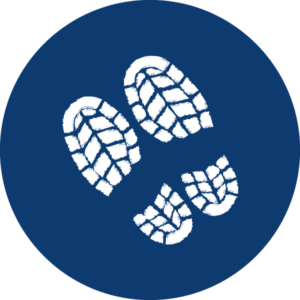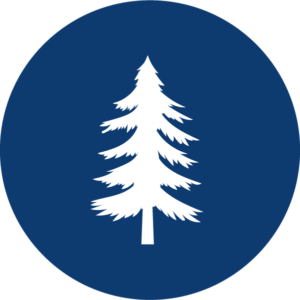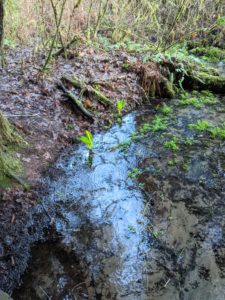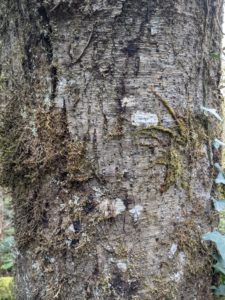
 Your Mission…
Your Mission…
Urban parks provide essential habitat for local wildlife and provide a nature outlet for humans too! Locate a large tree found in the park that you can photograph looking far up into its branches. In this scavenger hunt, you will use all your senses to learn about the forest.
KNOW BEFORE YOU GO!
The forested trails are shared, please watch for bicycles.
Print this handy mission checklist before you leave!
![]()
Route 94 (.04 mile walk)

 Welcome to LBA Park!
Welcome to LBA Park!
LBA Park is an urban forested park once having only recreation and sports fields. The park has expanded its initial boundaries to include LBA Woods. The City of Olympia purchased the adjoining wooded parcels which added miles of multi-use forested trails to the recreation park.
Using the 3500 Amhurst ST SE entrance by the tennis courts follow the map. If this lot is full you may access via the larger parking area located at 3333 Morse-Merryman RD SE.

 Trail Observations
Trail Observations
This trail wanders through a second growth native forest. What does it mean to be second growth? Once long ago the trees in this forest were harvested and the next generation of trees are referred to as second growth. Some of these trees may be 3 generations or third growth!
Along the way, keep an eye out for native plants like Indian plum, salal, evergreen huckleberry and Douglas fir. Can you identify them? All of these native plants provide valuable habitat for wildlife.
Can you think of ways these plants can be used by wildlife?
Food: Berries and seeds
Shelter: Shrubs provide homes for small mammals to rest and hide in. Also, trees provide homes and resting areas for many animals and insects too!

 More Observations
More Observations
Do you see any standing dead or fallen trees along the way? These are called snags.
Snags are rotting, dead standing trees and dead trees lying on the ground. Snags provide homes for many animals; insects for birds to eat, homes for salamanders and nesting places for birds, squirrels and raccoons. Some trees are still alive with broken tops. Broken topped trees provide homes for owls, squirrels and racoons and perches for owls and eagles. They are all part of a healthy forest. Eventually these decaying trees provide essential nutrients to the soil for other plants and trees to use.
In many of our forests, decaying logs and stumps are rare because they have been cleared away. It can take 500-1000 years to grow a large tree that falls and becomes a dead log in the forest. Please do not climb on or harm dead trees or stumps as they are an important missing habitat in our forests.
Some of these dead trees have holes in them. Do you know what animal makes these holes?
The small round holes are made by small woodpeckers. The larger rectangular holes are made by a pileated woodpecker. The pileated woodpecker is one of the biggest, most striking forest birds on the continent. It is nearly the size of a crow, black with bold white stripes down the neck and a flaming-red crest. Look (and listen) for pileated woodpeckers whacking at dead trees and fallen logs in search of their main prey, carpenter ants, leaving unique rectangular holes in the wood. The nest holes these birds make offer crucial shelter to many species including swifts, owls, ducks and bats.

 What Do You Hear?
What Do You Hear?
If you walk quietly and listen along the way, you will hear many animals in the forest.
If you are very quiet and very lucky you may hear the great horned owl that lives here. In the spring you may hear the male and female calling back and forth to each other. The great horned owl is our largest owl. It has ear tufts giving it its name and big yellow eyes.
You will also see and hear many other birds along the way like the spotted towee, Pacific wren, woodpeckers and other passerine migrants. Visit https://blackhills-audubon.org/birding-at-lba-woods/ for birding opportunities!
What else do you hear? Talking trees! As the wind blows you may hear the trees rubbing against one another making high screeching sounds.

 What Do You Smell?
What Do You Smell?
Throughout the forest, there are small spring – water streams coming out of the ground making the trail wet in places. Also forested wetlands where water pools during the wet part of the year. Can you smell the wet soils?
What essentials for survival do you think these springs and wet areas provide for wildlife?
Water for drinking. The plants and trees that need moist soils provide habitat or homes and food for many birds and small mammals. Small ponds provide areas for frogs, salamanders and aquatic insects. To learn more about wetland ponds visit the Nature Sleuths McLane Creek Nature Trail: Wetland Walk
Can you think of any small animals that would live in the forest?
You might find shrews and moles, frogs and salamanders, lizards, mountain beaver, skunks, squirrels, racoon and deer.
If you arrive in early spring or later in the fall you can also smell the leaves as they decompose into nutrients for the soil. It is all an important part of the ecology of the forest.

Touch
How many different trees have you seen along the way?
Notice some trees have different barks from each other. Can you feel the difference? Can you find and identify trees with smooth and rough bark?
Trees you will find in LBA Park include red alder, big leaf maple, Douglas fir and Western red cedar.
![]()
 All About Moss!
All About Moss!
What grows lush and green and likes it mostly shady and wet?
Moss…Mosses are the coolest plant!
Moss on the ground. Moss on the trees. Moss on the rocks. Even moss on sidewalks and rooftops. Moss grows everywhere there is water and sunlight!
Did you know? Moss has no true roots, flowers or fruit and their leaves are only one cell thick.
Watch this! Moss Life Cycle Under a Microscope
 Congratulations!
Congratulations!
You have completed your mission to locate a large tree that you can photograph looking far up into its branches! Don’t forget to login to the Goose Chase App and submit your photo for this mission to collect your park specific sticker!

